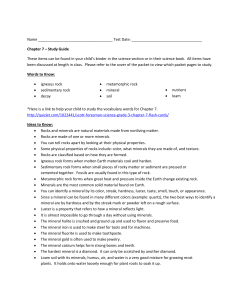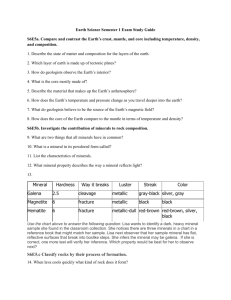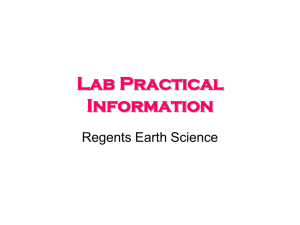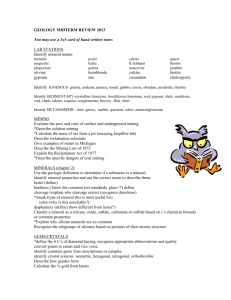Minerals, Igneous, Sedimentary, & Metamorphic Rock Notes KEY
advertisement
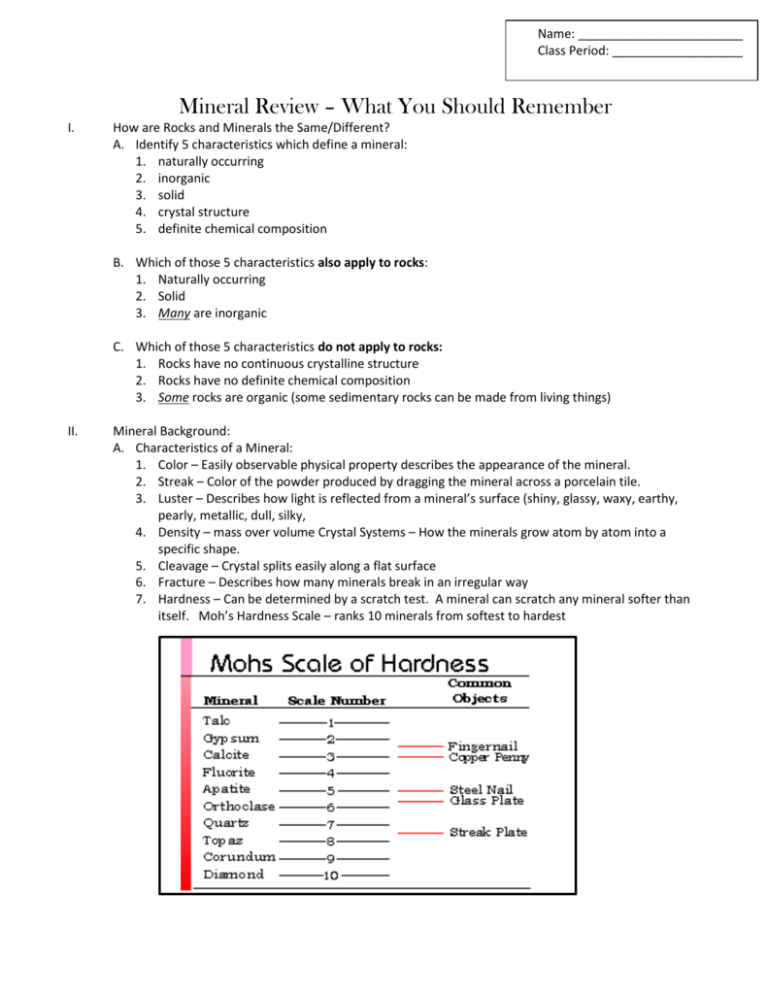
Name: ________________________ Class Period: ___________________ Mineral Review – What You Should Remember I. How are Rocks and Minerals the Same/Different? A. Identify 5 characteristics which define a mineral: 1. naturally occurring 2. inorganic 3. solid 4. crystal structure 5. definite chemical composition B. Which of those 5 characteristics also apply to rocks: 1. Naturally occurring 2. Solid 3. Many are inorganic C. Which of those 5 characteristics do not apply to rocks: 1. Rocks have no continuous crystalline structure 2. Rocks have no definite chemical composition 3. Some rocks are organic (some sedimentary rocks can be made from living things) II. Mineral Background: A. Characteristics of a Mineral: 1. Color – Easily observable physical property describes the appearance of the mineral. 2. Streak – Color of the powder produced by dragging the mineral across a porcelain tile. 3. Luster – Describes how light is reflected from a mineral’s surface (shiny, glassy, waxy, earthy, pearly, metallic, dull, silky, 4. Density – mass over volume Crystal Systems – How the minerals grow atom by atom into a specific shape. 5. Cleavage – Crystal splits easily along a flat surface 6. Fracture – Describes how many minerals break in an irregular way 7. Hardness – Can be determined by a scratch test. A mineral can scratch any mineral softer than itself. Moh’s Hardness Scale – ranks 10 minerals from softest to hardest B. How Minerals Form: 1. Crystallization – process by which atoms are arranged to form a material with crystal structure. 2. Magma & Lava Formation a) Hot magma cools inside the crust, or as lava hardens on the surface. When they cool they form crystals. b) Slow cooling = large crystals (amethyst inside a geode) c) Fast cooling = small crystals (like lava at the surface) 3. Minerals from Solutions – a) When elements and compounds that are dissolved in water leave the solution, crystallization occurs i. Solution – mixture in which one substance is dissolved into another b) Evaporation – water evaporates, leaving mineral crystals behind c) Hot water solutions – magma heats water, minerals dissolve, water cools, minerals precipitate in concentrated strips within other rocks i. Pure metals form veins Vein – narrow channel or slab of mineral different from surrounding rock because hot water/mineral solutions flow through the cracks in the rock C. Using Mineral Resources 1. Gemstones – hard, colorful mineral with brilliant or glassy luster 2. Metals a) can be flattened, widened, and molded (softer than gems) i. Examples: aluminum iron copper silver b) Can be combined to form stronger alloys 3. Other – foods, medicine, fertilizer, building material, talcum powder, make glass D. Producing metals 1. Rock containing mineral must be located through prospecting 2. The rock must be mined, or removed from the ground a) Strip Mines – scrape away the soil to remove ore b) Open Pit – can be 1 km wide and 1 km deep c) Shaft – network of tunnels to follow veins of ore 3. Rock must then be processed to extract the metal. Rock with mineral = ORE a) Smelting – process to separate an ore from other substances.’ i. Iron ore (hematite Fe2O3) is crushed and mixed with crushed limestone and coke (baked coal …carbon) ii. Mix is heated iii. As coke burns, chemical change produces CO2 and molten Fe iv. Dense Fe sinks to bottom of furnace; impurities in ore + limestone = slag **Density** v. Slag and molten iron poured out through taps b) Alloy – solid mix of 2 + elements and characteristic properties of a metal (eg. C + Fe = steel) Name: ____________________ Date: _____ Class Period: ____ Rock Notes – Laying the Foundation III. How to Classify Rocks A. Mineral composition – About 20 minerals make up most rocks. Some rocks are just 1 mineral B. Color 1. Light colored rocks a) High silica content b) Example: Granite 2. Dark colored rocks a) Low silica content b) Example: Basalt C. Texture 1. The look and feel of the rock’s surface, determined by the size, shape and pattern of the grains 2. Grains: particles of minerals or other rocks which give a rock its texture a) No crystallization (example: Obsidian) b) Fine (example: slate) c) Coarse (example: granite) d) Very coarse (example: conglomerate) D. Formation 1. Sedimentary – particles of other rocks, plants, animals pressed together 2. Metamorphic – existing rock changed by heat, pressure or chemical reaction 3. Igneous – Cooling of molten rock IV. Classifying Igneous Rocks A. Origin 1. Intrusive a) formed by cooling of magma b) hardened beneath the surface c) usually have larger crystals due to slow cooling 2. Extrusive a) formed by cooling of lava b) hardened on Earth’s surface c) usually have smaller crystals due to fast cooling d) Often have a fine grained or glassy texture B. Texture 1. Size & shape of mineral crystals (except volcanic glass lacks crystal structure) a) Rapid cooling –small crystals, fine/glassy texture (extrusive) b) Slow cooling – large crystals, coarse grain (intrusive) C. Mineral Composition 1. Silica a) Low silica – dark rocks (basalt), lava b) High silica – magma, light colored (granite) D. Uses of Igneous Rocks 1. Tools and Building Materials throughout history V. Sedimentary Rocks A. What is a Sedimentary Rock? a. 75% of rocks on Earth’s surface b. Where they form i. At the surface (give examples) 1. Beaches 2. Rivers 3. Ocean c. Made from i. Clastic – Made from broken bits of other rocks which are cemented together over time ii. Chemical – Made from mineral crystals precipitating out of solution iii. Organic –Made from remains of living things B. Clastic Sedimentary Rocks a. Made of i. Sediment – little pieces of other rocks ii. Cement – mineral crystals which hold sediment together b. Examples and their environments i. Sandstone 1. Made of sand grains 2. Forms at beach or sand dunes ii. Shale 1. Made of mud or clay 2. Formed at bottom of a lake or swamp iii. Conglomerate 1. Made of large chunks of gravel or sand 2. Forms at the bottom of a stream c. How to form a Clastic Sedimentary Rock i. Weathering – breaks rocks apart ii. Erosion – carries sediments away (usually by wind or water) iii. Deposition – Sediments are deposited somewhere new iv. Lithification – Turning a pile of sediment into a solid rock C. Chemical Sedimentary Rocks a. Made of i. Mineral crystals that have precipitated out of water ii. Example: Salt from sea water (halite) b. How it forms i. Too many solids in water, and no more will fit ii. Water evaporates and leaves mineral crystals behind D. Organic Sedimentary Rocks a. Made of organic matter (fossils) 1. Calcite a. Bones b. Shells c. Creates LIMESTONE 2. Silica a. Microrganisms (living things too small to see without a microscope) b. Creates Chert 3. Plants a. Coal EROSION VI. Metamorphic Rocks A. What is a Metamorphic Rock a. “Change form” in Greek b. Heat and pressure deep inside Earth’s surface can CHANGE ANY ROCK into a metamorphic rock by CHANGING the following: 1. Appearance 2. Texture 3. Crystal Structure 4. Mineral Content c. How can it happens 1. Earth’s plates collide, pushing one layer of rock down toward the mantle. 2. Pockets of magma rise up and add heat to existing rock layers 3. Rocks buried deep in the surface are under pressure, and temperatures can be many times hotter than at the surface B. Types of Metamorphic Rock a. Foliated – i. grains are arranged into layers or bands ii. may split into layers iii. Examples 1. Shale (sedimentary) becomes SLATE (metamorphic) 2. Granite (igneous) becomes GNEISS (metamorphic) b. Non-foliated – i. grains are arranged randomly ii. Do not split into layers iii. Examples 1. Sandstone (sedimentary) becomes QUARTZITE (metamorphic) 2. Limestone (sedimentary) becomes MARBLE (metamorphic) C. Uses of Metamorphic Rock a. Building materials, monuments, roofing and walkways




